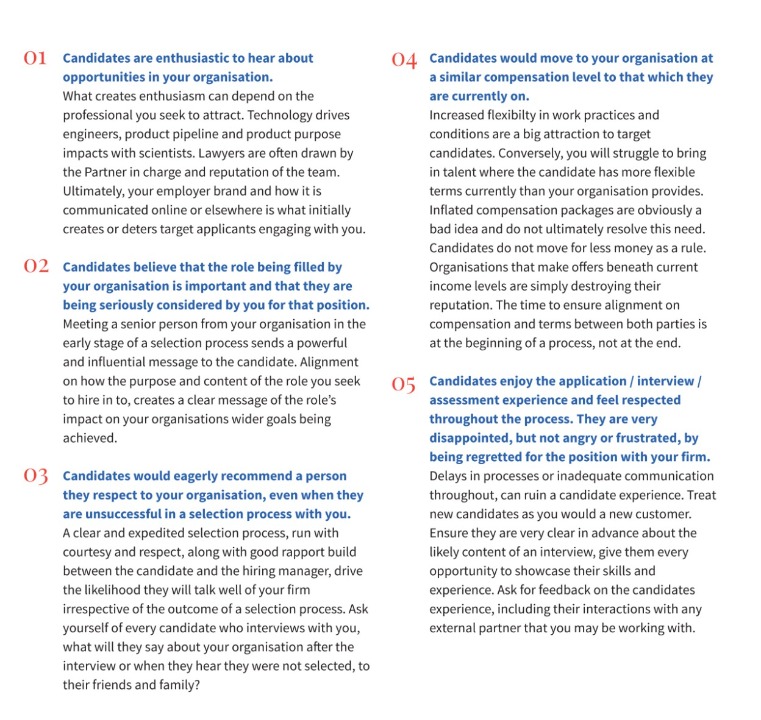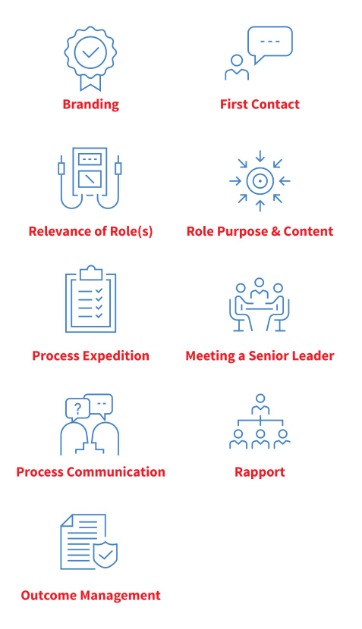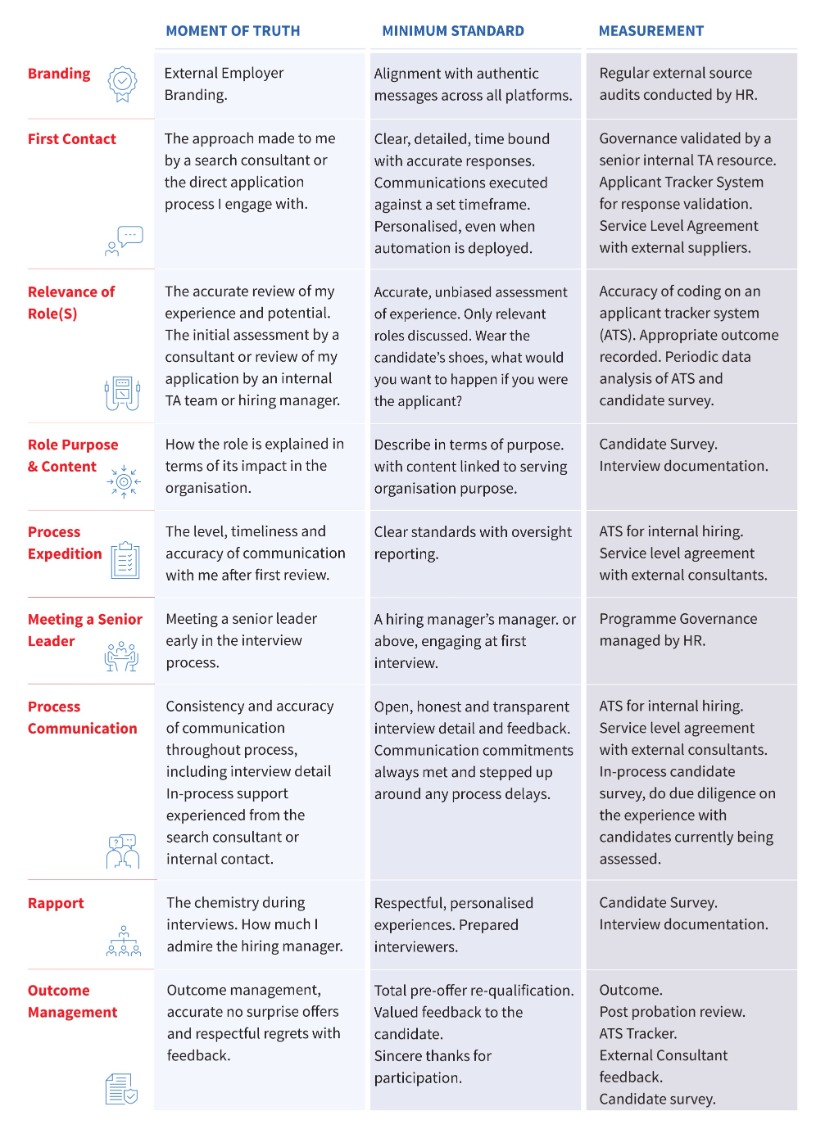As we emerge from a sustained period of unprecedented challenges, employers now face acute talent shortages. These arise due to a convergence of factors including the shape of the economic recovery, changes in skill requirements and the implementation of plans and projects put on hold during the pandemic period.
We also know from our research this year that the overall experience a candidate has during your hiring process is the most important factor influencing their decision to stay in that process and ultimately to join your organisation. Companies develop expensive brand strategies to promote their products and services but often pay insufficient attention to employer branding. Similarly, firms work hard to create great customer experiences but rarely commit as hard to candidate experiences during their application and hiring processes. Why is this? The risk to customer relationships and the cost of under-performance, arising from poor or compromise recruitment decisions is significant.
Great companies are such because of the great talent they attract. Getting the candidate experience right means lower cost recruiting salaries and better choice of talent at the end of the process. It means roles being open for shorter periods and reduced burden on current headcount. Hiring great talent encourages your organisation’s current employees and positively influences your target talent pools for future needs.
Bad news travels fast, sometimes the inability to attract suitable professional or leadership talent to a current role, can be due to the experience others may have had (and shared) during previous hiring processes with your company. Creating a consistently high standard of candidate experience is a challenging undertaking. There are quick wins but to culturally embed the right behaviours, requires three core elements:
1. Clear expected outcomes by which your organisation can measure the candidate experience
2. Commitment to the nine Candidate Moments of Truth (CMOT’s) in a candidate experience
3. The organisation conditions necessary to consistently achieve high CMOT performance.
The research behind this report on Candidate Experience was undertaken by surveying just under two thousand professional and leadership candidates in June 2021. It reveals that while the role purpose, as described to the candidate at interview, remains the most important factor, what candidates learn about your firm before they meet with you is their second highest influence. The third most impactful factor is how the candidate is approached by the search firm or your internal talent acquisition team. Poor preparation, presentation and detail at this point, turns away excellent candidates who might otherwise have been interested in engaging with your organisation.
Five Outcome Goals from a candidate experience programme your organisation must work towards:


Nine Candidate Experience Moments of Truth (CMOTs) that your experience must be built around:
Most people are familiar with the concept of Moments of Truth. They are the touch points in a stakeholder’s journey with your organisation that determine their overall perspective of your company. Each Candidate Moment of Truth (CMOT) represents the minimum standard of experience a stakeholder should have at that point in their journey with you. However, it is the combination of all CMOTs working consistently that creates a valued experience for candidates, one that is difficult for others competing for the same talent, to replicate.
CMOTs must be clearly defined and measurable so that all participants in the assessment process know what to do and that they do it consistently. Borne from our research, a pattern runs through the nine CMOTs. It is that clarity and alignment of role purpose is of great significance to candidates, throughout your selection process and in their decision making. Candidates want to feel that the role matters and that your organisation is the right place in which to serve that purpose.
For CMOTs to impact, there must be clear understanding by all process participants of what is expected. Each CMOT must have a minimum standard of experience and be measurable. The table below sets out an example of how this might appear:

Nine necessary conditions to achieve consistent CMOT performance and desired outcomes in candidate application and assessment processes:
To achieve sustainable change in hiring outcomes, the whole organisation including people, practices and processes must be reviewed and engaged. As strategy is designed top down and implemented bottom up, leadership commitment is essential. So to, is an honest, frank appraisal of everyone engaged in hiring processes of any kind. We identify nine environmental conditions that must be in place in order to achieve great hiring outcomes, under three headings, Leadership and Outcomes; Systems and Performance and People and Culture:
1. Leadership and Outcomes – Are leaders committed, do they ask the right questions of their hiring managers and are they reviewing the performance data, up to and after hire, and address gaps that arise?
Oversight-Leadership assessment of CMOT performance and hiring outcomes.
Sponsorship -Consistency seen as a top team priority. Performance recognised, under performance addressed.
Outcomes -Outcomes achieved, CMOT programme and related initiatives regularly evaluated for iteration.
2. Systems and Performance– Are systems, tools and measurements accurate and fit for purpose?
Processes - Fit for purpose, efficiency and effectiveness, internal and external stakeholder service orientation, consistency of application.
Systems - Digital applications with accurate data to deliver consistent experiences, accurate tracking and good faith leverage.
Measurement - Objective assessment of performance against CMOT experience programme at key data points per hire.
3. People and Culture– How do we do things around here?
Mindset - Capacity to consider alternative sources of talent. General agility in decision making.
Culture - How hiring is done around here, what we believe to be the ‘right’ way, willingness and ability to change.
Capability- Quality/level of resources in place, freedom to act, high stakeholder service orientation, alignment with outcomes.
The battle for great talent has been with us for years but candidates are now more sophisticated in their decision making. They understand that they have choice and following the pandemic, their expectations have shifted considerably in terms of what really matters in their employer relationships.
One thing we can state with certainty; while you may be able to hire employees, to attract great and discerning talent, the point at which you commence working on their engagement is not when they start with your company, it’s when they start showing potential interest in your organisation.
The organisations who understand all this and deliver great candidate experiences, are those who continually win the battle for the best talent.
DOWNLOAD


